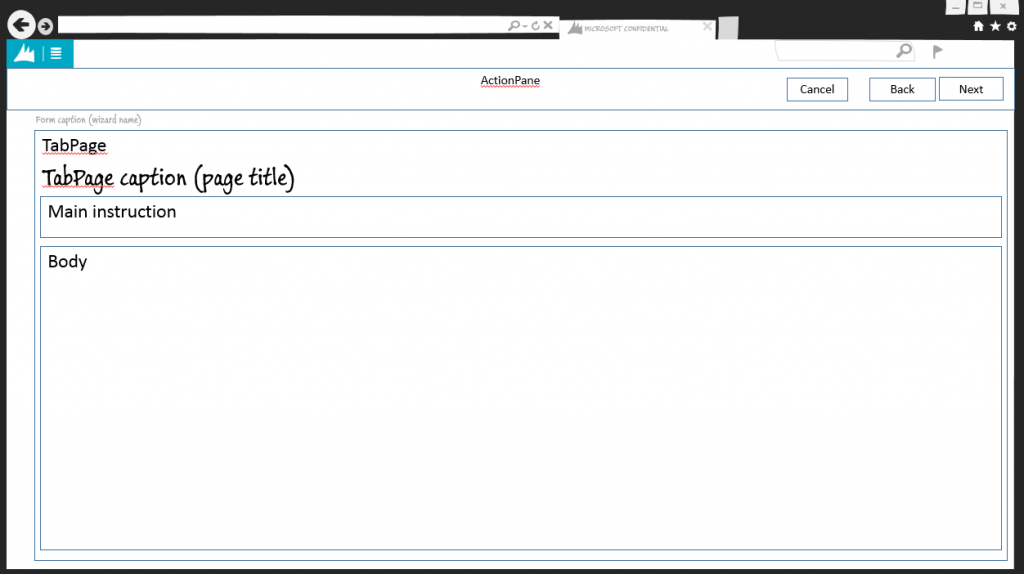Wizard form pattern
This article provides information about the Wizard form pattern. A wizard is a special form of user assistance that takes the user through a task by using an ordered series of tab pages.
Usage
A wizard is a special form of user assistance that takes the user through a task by using an ordered series of tab pages. Wizards are especially useful for complex or infrequent tasks that the user might have difficulty learning or doing, or for tedious, frequently performed tasks.
Wireframe
Pattern changes
Here are the main changes to this pattern since Microsoft Dynamics AX 2012:
- The secondary instruction for a wizard step was previously defined in the Help Text property of that step’s Tab Page. This instruction will now be modeled on the Tab Page as a Static Text control.
Model
High-level structure
Design (Style=Wizard; Caption=<wizard title>)
WizardContent (Tab)
WizardContentPage (TabPage) [repeats 1..N times, can be named anything; Caption set to page title]
- MainInstruction (StaticText)
- Body (Group)
Core components
- Apply the Wizard pattern on Form.Design.
- Address BP Warnings:
- Design.Caption isn't empty.
- The form must be referenced by at least one menu item.
- TabPage.Caption isn't empty (for all wizard content pages).
- MainInstruction.Text isn't empty (for all wizard content pages).
Commonly used subpatterns
UX guidelines
The verification checklist shows the steps for manually verifying that the form complies with UX guidelines. This checklist doesn't include any guidelines that will be enforced automatically through the development environment. Open the form in the browser, and walk through these steps.
Standard form guidelines:
- Standard form guidelines have been consolidated into the Microsoft Dynamics AX General Form Guidelines document.
Wizard guidelines:
- Each tab page should have a title.
- Each tab page should have a main instruction.
- Content should be subdivided into logical groups per page.
- A wizard should have <Next> and <Previous> buttons on the appropriate pages.
- The user should also be able to cancel the wizard, and cancellation should return to the state that existed before the wizard was started.
- Only one question should be asked per wizard page (tab page).
- When a set of choices is presented to the user, radio buttons should be used to make the alternatives clear, even if a check box or combo box is otherwise acceptable.
- Wizard forms must not have these elements:
- FactBoxes
- FastTabs
Examples
Form: WrkCtrBulkResReqEditWizard

Appendix
Frequently asked questions
This section will have answers to frequently asked questions that are related to this guideline/pattern.
Open issues
- None
AX 2012 content
AX 2012 links
AX 2012 example
Comentarios
Próximamente: A lo largo de 2024 iremos eliminando gradualmente GitHub Issues como mecanismo de comentarios sobre el contenido y lo sustituiremos por un nuevo sistema de comentarios. Para más información, vea: https://aka.ms/ContentUserFeedback.
Enviar y ver comentarios de

